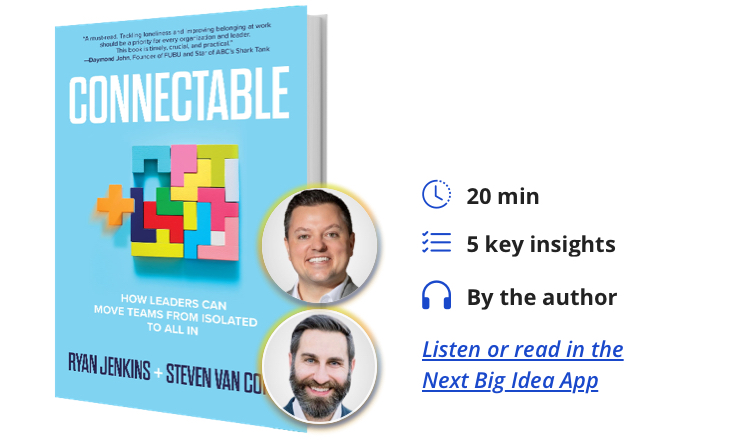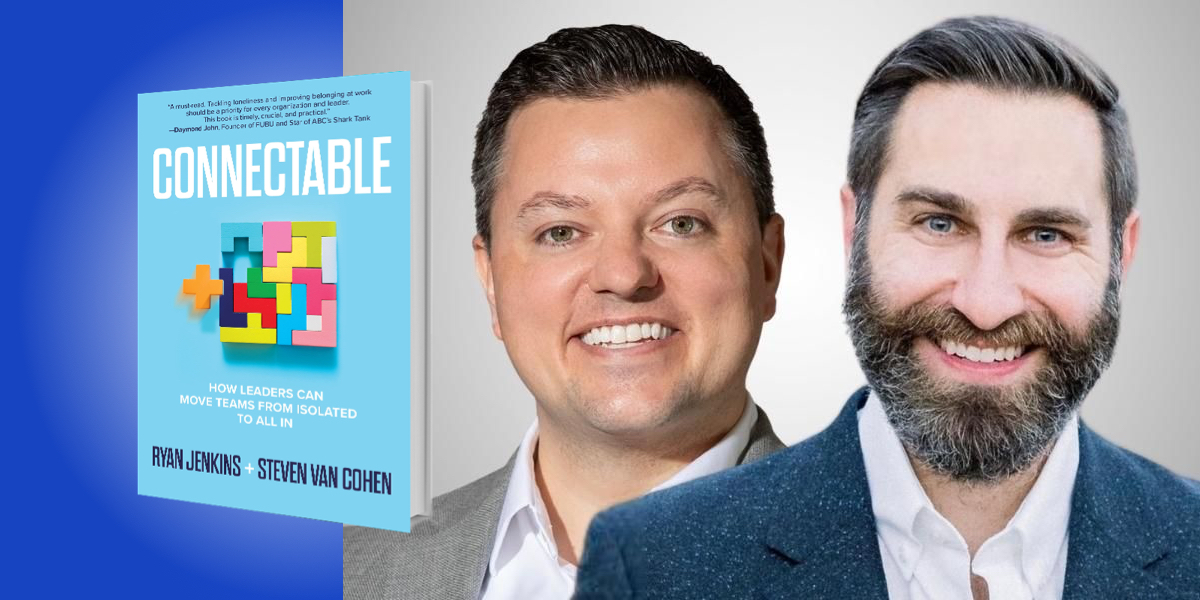Ryan Jenkins and Steven Van Cohen are authors, speakers, and leadership consultants. They have spent the past decade helping companies like The Home Depot, Salesforce, Bank of America, and Delta Air Lines prepare for the future of work—including how to adapt to a world of growing isolation.
Below, Ryan and Steven share 5 key insights from their new book, Connectable: How Leaders Can Move Teams from Isolated to All In. Listen to the audio version—read by Ryan and Steven themselves—in the Next Big Idea App.

1. Loneliness isn’t shameful—it’s a signal.
Humans are social creatures. We have a deep desire to be accepted, cared for, and involved in meaningful communities. Our ancestors, who roamed the plains, lived in tribes for a reason. While some people hunted and gathered food, others created tools, prepared shelter, or protected community resources. We didn’t survive because we are bigger, stronger, faster, or more ferocious than our predators. We survived because our ancestors were able to lean on one another. Becoming separated or banished from the tribe made survival unlikely.
This explains why loneliness creates a psychological stress state that leads to higher levels of inflammation in the body. Our biological survival instinct to remain one with the pack is engrained in our DNA to this day. Akin to hunger, loneliness is our biological signal to seek connection. Hunger motivates us to eat, and loneliness motivates us to connect. It’s a motivational force to forge strong relationships—a force that can transform organizations and communities for the better, when belonging is present. It’s an innate reminder that our presence matters to others. It’s proof that we need each other. Understood in this context, loneliness is not an embarrassing black eye displayed by few, but a birthmark we all have.
Belonging is such a strong survival instinct that it’s important to address it at work. If left unaddressed, our bodies will react as if we are alone and lost in the wilderness surrounded by wolves. The hypervigilance that was embedded in our nervous system centuries ago to help us survive isolation will come roaring back, derailing our ability to collaborate, innovate, and communicate with a team.
“Loneliness is not an embarrassing black eye displayed by few, but a birthmark we all have.”
Nothing of significance is ever created alone. The book you read, the phone you check, the building you sit in—they all exist because a group of people came together to build it. Together we dream, build, and grow. Mother Teresa offers this beautiful reminder about our interdependence: “If we have no peace, it is because we have forgotten that we belong to each other.”
2. Loneliness is an invisible mental health bully disrupting how we work.
Picture this: you step into the middle of the Ultimate Fighting Championship Octagon as 2,600 fans scream your name. You open your arms like the wings of a bird, ushering in the cheers. You’re trying to absorb their energy and confidence before you clash with your menacing opponent. The referee drops her hand and the fight begins. Throwing technique to the wind, your opponent lunges toward you, landing a crushing kick to your abdomen. You’re stunned, but bounce back because you’re a professional fighter and you’re at work.
Have you ever been kicked in the gut and then been expected to actively participate in a team meeting? Though for most working professionals it won’t be a physical blow, participating through physical pain is more familiar to lonely workers than you may think.
Researchers conducted an experiment where participants experienced exclusion from a group. They used an fMRI scanner to look at the participants’ brain activity and discovered that the part of the brain that was activated when being excluded was the same part that responds to physical pain. The sensory fibers in our brains that register physical and emotional pain overlap. That means exclusion, disappointment, bereavement, or loneliness are felt biologically the same as being physically hit. In short, feelings can be just as disruptive as physical ailments.
How could anyone expect a workforce to show up with these ailments? According to our research, 72 percent of global workers experience loneliness monthly, with 55 percent experiencing it weekly. It’s very likely that you or your team are experiencing loneliness and struggling to bring your capable selves to work. It’s as if we are asking workers to fully focus or deliver delightful customer experiences while being physically and mentally assaulted by an invisible bully. Lonely workers are distracted at best, and debilitated at worst.
“If an employee arrived at work with a bleeding appendage, you wouldn’t ask her to get to work. You’d address the injury and assess if she were fit for duty.”
It’s not an exaggeration to say that loneliness is devastating workers and their organizations, silently incapacitating many and wreaking havoc on engagement, retention, and overall performance. If an employee arrived at work with a bleeding appendage, you wouldn’t ask her to get to work. You’d address the injury and assess if she were fit for duty. The same level of care should be applied to the social and emotional needs of the team.
This isn’t a “soft” topic—it’s a dire one. In the same way organizations promote physical fitness to help workers improve their well-being, social fitness must also be promoted and practiced.
3. Work is full of loneliness lifelines.
Work is a major source of loneliness. Remote working, switching to a new team, eating lunch while answering emails, or having no one to talk to on an “off” day can all contribute to feeling lonely. Steve Cole, a leading researcher on loneliness and professor of medicine, psychiatry, and biobehavioral sciences at UCLA says, “Lonely people’s brainstems are saying, ‘I need to be ready to be hurt. I need to be vigilant for people taking advantage of me. I need to watch out and take care of myself. I need to let people in only gradually, so they don’t do what they have done before.’”
Lonely people lack trust. They are apprehensive to let others in, and they keep a wide distance in social settings. They put up an imaginary barrier, like the Great Wall of China, which snakes around their entire emotional response system, creating a blockade. The longer someone experiences loneliness, the higher and stronger the walls.
Fortunately, researchers have discovered a “secret door,” allowing someone to get past the wall undetected: purpose. Purpose is a premier loneliness suppressant. Nothing squashes loneliness quite like contributing to a worthwhile goal and feeling a part of something bigger than oneself. A powerful sense of belonging stems from the human desire to utilize one’s strengths to make a contribution that is valued by the team. Being needed reduces the risk of social abandonment, ultimately freeing people to do higher-level work.
“Nothing squashes loneliness quite like contributing to a worthwhile goal and feeling a part of something bigger than oneself.”
Researchers, trying to identify key drivers of social cohesion among thousands of employees, recently discovered that creating opportunities to build shared meaning with colleagues had the biggest effect on moving teams from disconnected to connected. Workers who reported high levels of social support and a strong sense of shared meaning with colleagues were 30 percent more likely to get a raise for superior work. Intent to quit fell by 24 percent. According to other research, Gen Z workers are 2.5 times more likely to stay with their employer for five or more years if they feel their skills are fully utilized with challenging, meaningful work. This is important to note because, before COVID hit, research highlighted that 73 percent of Gen Z workers reported sometimes or always feeling alone.
The healthiest organizations have found a way to concurrently commit to human dignity and performance. They don’t sacrifice the well-being of employees for high performance. They also don’t sacrifice performance to bend to every need of their employees. They strike a balance. When organizations commit to lessen worker loneliness, it improves employee well-being and enhances organization excellence, as lonely workers are seven times more likely to be disengaged at work, five times more likely to miss work, and twice as likely to think about quitting.
4. Reducing loneliness takes less effort than you might think.
Because loneliness is rising, it means it’s malleable, and thus can also decline. According to psychologists, the best way to lessen loneliness is through “prosocial behavior.” Prosocial behaviors are actions of comforting, sharing, helping, or cooperating that are backed by a general concern for the feelings, welfare, and rights of other people. Researchers in China found that leaders who show compassion to their employees can mitigate the negative effects of loneliness and thereby boost creativity. Another study of workers at Coca-Cola’s Madrid headquarters found that leaders were able to reduce feelings of isolation among their team by simply being nice and interacting with others.
Your behavior lessens loneliness—just small, intentional, and routine behaviors. People on the receiving end of prosocial behavior were a whopping 278 percent more likely to engage in prosocial behaviors themselves. The ripple effect of lessening loneliness with prosocial behaviors is gigantic.
“Social creatures have a social muscle that requires social fitness, and every person has the power to improve theirs.”
Loneliness directly conflicts with being human. Social creatures have a social muscle that requires social fitness, and every person has the power to improve theirs. Research shows that simple pro-social behaviors reduce loneliness in as little as a 40 seconds. Having meaningful one-on-one conversations, befriending one person at work, spending five minutes to share something personal before or after a virtual meeting, and trading high-tech for high-touch communications, all help people feel seen. Prosocial behaviors are transformational—and it only takes you. There are subtle shifts you can make to completely change the well-being of your entire team.
5. Be more interruptible.
Healthy and happy leaders and team members are interruptible. They don’t let tasks and deadlines override relationships. They have the necessary margin and self-permission to say no to the urgent and lean into the important. If you wish to be a memorable and impactful team member, the discipline of being interruptible is a must.
Interruptions can be costly and stressful, but so is busyness. Considering that busyness is a leading cause of loneliness, practicing interruptibility will deliver a swift blow to loneliness. The decrease in loneliness is immediate for yourself because you’re present and connecting, and it’s immediately beneficial for the other party because they sense your presence in that moment.
Being interruptible is about intentionally placing your focus, productivity, and priority on the organization’s number one asset: people. Parting with your most precious resource—your attention—makes others feel seen, appreciated, and included. Productivity is not about squeezing people, but about showing up for them. Leave “never drifting off task” to the robots. Drifting off task and wading into the lives of others is best suited for a strong professional.
In fact, relationships are stronger when two people respond to each other’s requests for connection. Psychologist John Gottman calls these requests “bids.” According to his research, married couples who regularly turned toward (or engaged) the bid, versus those who regularly turned away from the bid, had much stronger connections. Gottman found specifically that couples who had divorced after a six-year follow-up had “turn-toward bids” 33 percent of the time. Only three in 10 of their bids for connection were met with acknowledgment or support. The couples who were still together after six years had “turn-toward bids” 87 percent of the time. Nine in 10 of their bids for connection were met with acknowledgment or support.
When workers are connected to their team, the work, and their leader, they are stronger, healthier, and more useful. Just like a smartphone was built to connect with other technology, humans are built to connect with other humans. We are all connectable. However, without the appropriate action, our collective connect-ability will become dormant, stripping humanity of its very essence. Together, we can awaken the renewed sense of connection that humanity is silently screaming for, because work is the most fertile ground for connection to spring forth.
To listen to the audio version read by co-authors Ryan Jenkins and Steven Van Cohen, download the Next Big Idea App today:





























